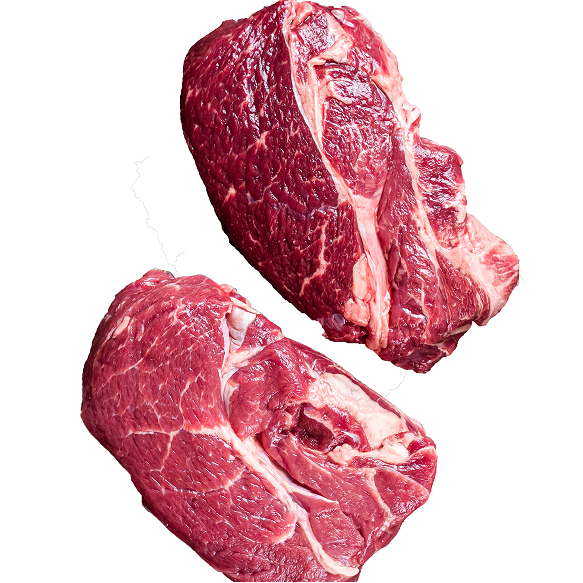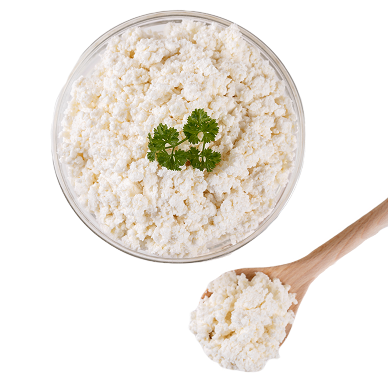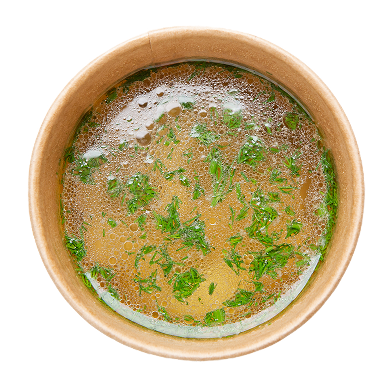Grass-Fed Beef
Grass-fed beef is a nutrient-dense protein source that comes from cattle raised on a diet of pasture plants, such as grasses and clover, rather than grain-based feed.
It is considered a superior choice compared to conventionally raised beef due to its higher nutritional profile, including an increased amount of omega-3 fatty acids and antioxidants. Grass-fed beef also tends to be leaner, offering a healthier fat profile with less saturated fat.
Read More
One of the key benefits of grass-fed beef is its higher levels of conjugated linoleic acid (CLA), a type of fat that has been associated with various health benefits, including improved fat metabolism and reduced inflammation. Grass-fed beef also contains higher amounts of vitamins, including vitamin E and vitamin A, as well as important minerals like zinc and iron, which are essential for maintaining good health.
Incorporating grass-fed beef into your diet is an excellent way to provide your body with high-quality protein and essential nutrients. It can be used in a variety of dishes, such as steaks, roasts, and ground beef, and is a great addition to a balanced, nutrient-rich diet.
Recommended Intake
- A moderate portion of 85-120g (3-4 ounces) per meal as part of a balanced diet.
Tips
Avoid
Benefits
- Higher in omega-3 fatty acids, promoting heart health and reducing inflammation.
- Rich in CLA, supporting fat metabolism and improving body composition.
- Packed with vitamins and minerals, including vitamin E, vitamin A, zinc, and iron.
- Leaner fat profile with less saturated fat compared to conventionally raised beef.
Grass-Fed Beef Liver
Grass-fed beef liver is a nutrient-dense superfood that comes from cattle raised on natural pastures, allowing them to graze freely and consume a diet rich in grass. This natural feeding process results in a healthier and more nutritious liver, packed with essential vitamins and minerals that support overall well-being.
One of the key benefits of grass-fed beef liver is its exceptional nutrient profile compared to conventionally raised beef liver.
Read More
It is an excellent source of iron, which supports red blood cell production and energy levels, as well as vitamin A, which promotes healthy vision, immune function, and skin health. Additionally, it contains high amounts of B vitamins, particularly B12, which is crucial for brain function and energy metabolism. Incorporating grass-fed beef liver into your diet is an excellent way to boost your intake of essential nutrients. It can be prepared in various ways, such as pan-seared liver, liver pâté, or incorporated into stews and casseroles for enhanced flavour and nutrition.
Recommended Intake
- A moderate portion of 85-120g (3-4 ounces) per meal as part of a balanced diet.
Tips
- Choose grass-fed beef liver that is organic and pasture-raised for the best quality and nutrient content.
- Store liver in a cool, dry place and keep refrigerated or frozen for freshness.
- Soak liver in milk or lemon juice before cooking to reduce its strong flavour.
- Pair with vitamin C-rich foods like citrus fruits or bell peppers to enhance iron absorption.
Avoid
- Excessive consumption of liver due to its high vitamin A content—balance with other protein sources like fish, beans, or legumes.
- Choose grass-fed options over conventionally raised liver to avoid potential exposure to toxins from grain-fed cattle.
Benefits
- Rich in iron, supporting red blood cell production and energy levels.
- High in vitamin A, promoting vision, immune function, and skin health.
- Excellent source of B12, essential for brain function and energy metabolism.
- Comes from grass-fed cattle, ensuring a more natural and nutrient-rich product.
Free-Range Chicken
Free-range chicken is a high-quality protein source that comes from chickens raised with access to the outdoors, allowing them to roam freely and forage for insects, seeds, and plants.
This natural lifestyle contributes to a healthier and more nutritious bird, as the chickens are able to engage in natural behaviours that improve their physical health and well-being.
Read More
Recommended Intake
- A moderate portion of 85-120g (3-4 ounces) per meal as part of a balanced diet.
Tips
- Choose free-range chicken that is organic and pasture-raised for the best quality and nutrient content.
- Store chicken in a cool, dry place and keep refrigerated or frozen for freshness.
- Opt for whole free-range chickens or skinless chicken breasts for leaner, healthier meals.
- Pair with colourful vegetables for a nutrient-rich, balanced meal.
Avoid
- Excessive consumption of poultry—balance with other protein sources like fish, beans, or legumes.
- Choose free-range options over conventionally raised chicken to avoid the use of hormones and antibiotics in farming.
Benefits
- Higher in omega-3 fatty acids, promoting heart health and reducing inflammation.
- Rich in vitamins E and D, supporting immune function and bone health.
- Leaner meat with less fat compared to conventionally raised chicken.
- Raised with access to the outdoors, allowing for healthier and more natural living conditions.
Organic Free-Range Eggs
Organic, free-range eggs are nutrient-dense, known for their versatility and rich nutrient profile. They are an excellent source of high-quality protein, essential amino acids, and healthy fats. Free-range eggs, produced from hens that have access to outdoor environments, are often richer in nutrients compared to conventionally farmed eggs, including higher levels of omega-3 fatty acids and vitamins like vitamin D and E.
Read More
The functional benefits of organic, free-range eggs lie in their high content of choline, a nutrient that supports brain health and cognitive function. They are also rich in antioxidants, including lutein and zeaxanthin, which contribute to eye health by reducing the risk of age-related macular degeneration. Additionally, eggs are an excellent source of B-vitamins, which aid in energy production and support overall metabolic function. With their diverse nutrient profile, organic, free-range eggs support brain, eye, heart, and skin health, making them a valuable addition to any diet. Incorporating organic, free-range eggs into your daily meals is simple and delicious. They can be boiled, scrambled, poached, or made into omelettes. Eggs can also be added to baked goods, smoothies, or used as a binding agent in various recipes.
Recommended Intake
Tips
- Choose organic, free-range eggs for higher nutritional quality and ethical sourcing.
- Store eggs in the fridge to maintain freshness and prevent bacterial contamination.
- Pair eggs with nutrient-dense foods like vegetables, whole grains, or avocado for a balanced meal.
- Experiment with different cooking methods such as poaching or scrambling for variety.
Avoid
- Overcooking – Overcooked eggs may become rubbery and lose some of their nutritional value.
- Consuming raw or undercooked eggs – This can increase the risk of foodborne illness.
Benefits
- Rich in high-quality protein and essential amino acids, supporting muscle repair and growth.
- High in omega-3 fatty acids, promoting heart health and reducing inflammation.
- Contains antioxidants like lutein and zeaxanthin, supporting eye health.
- Packed with choline for brain function and cognitive health.
- A great source of B-vitamins for energy production and metabolic support.
Myth: Eggs raise cholesterol levels and increase the risk of heart disease. While eggs do contain cholesterol, they don’t raise blood cholesterol levels for most people. The body regulates cholesterol production, so when you eat eggs, the liver produces less cholesterol to maintain balance. Eggs have been shown to actually improve cholesterol profiles by raising HDL (good) cholesterol and lowering LDL (bad) cholesterol in many individuals. The healthy fats, especially omega-3s found in eggs, reduce LDL cholesterol and lower the risk of oxidized LDL, which can contribute to heart disease. Additionally, the phospholipids in eggs, like lecithin, help emulsify and transport cholesterol, preventing it from building up in the arteries. Furthermore, eggs are a rich source of choline, which plays a vital role in brain health by supporting neurotransmitter production (like acetylcholine, crucial for memory and cognitive function) and liver health by aiding in fat metabolism and preventing fatty liver disease. Far from raising cholesterol, eggs support healthy brain function, liver health, and heart health, helping to maintain a healthy cholesterol balance and reducing the risk of cardiovascular disease.
Sardines
Sardines are a nutrient-dense, small fish renowned for their rich profile of essential vitamins, minerals, and omega-3 fatty acids. Packed with protein, sardines are an excellent source of high-quality, complete protein, making them a valuable addition to any diet. Their natural oils are rich in omega-3 fatty acids, particularly EPA and DHA, which support heart health by reducing inflammation, improving cholesterol levels, and promoting overall cardiovascular well-being.
Read More
Sardines also provide a host of other vital nutrients, including calcium, vitamin D, and B-vitamins, making them an ideal food for maintaining strong bones and a healthy metabolism.
The functional benefits of sardines come from their exceptional omega-3 content, which contributes to cognitive function, reduces the risk of heart disease, and supports joint health. Additionally, sardines are a great source of vitamin D, essential for bone health and immune system function, as well as calcium, which further supports bone density. Their B-vitamins, particularly B12, are crucial for energy production, red blood cell formation, and neurological health. With their rich nutrient profile, sardines help support heart, bone, brain, and immune health, making them a superfood for overall wellness.
Incorporating sardines into your diet is simple and versatile. Enjoy them as a quick snack, on whole-grain toast, in salads, or mixed into pasta dishes. Sardines can also be used in Mediterranean-style recipes, such as fish cakes or as a topping for pizzas and sandwiches.
Recommended Intake
- 1 can (around 120-150g) of sardines, two to three times per week, to meet omega-3 and nutrient needs.
Tips
- Choose sardines packed in extra virgin olive oil for added healthy fats and a rich taste.
- Look for sustainably sourced sardines to support eco-friendly fishing practices.
- Pair with fresh vegetables, whole grains, or legumes for a balanced meal.
- Add sardines to salads or wraps for an easy protein-packed option.
Avoid
- Overeating – While nutrient-dense, sardines are high in sodium, so it's best to consume them in moderation as part of a balanced diet.
- Opting for sardines with high levels of added salt – Choose options with minimal added sodium to maintain a healthy salt intake.
Benefits
- Rich in omega-3 fatty acids, promoting heart health and reducing inflammation.
- Excellent source of vitamin D and calcium for strong bones and immune support.
- Packed with B-vitamins like B12, which support energy production and neurological health.
- High in complete protein, aiding in muscle repair and overall body function.
- Supports brain health and cognitive function through its nutrient profile.
Cottage Cheese
Cottage cheese is a nutrient-packed functional food, known for its light, creamy texture and impressive health benefits. It is an excellent source of high-quality protein, primarily casein, which supports muscle growth, repair, and overall metabolic function. Cottage cheese also contains a unique combination of probiotics, calcium, and essential amino acids, making it a versatile addition to any diet.
Read More
Recommended Intake
- ½ to 1 cup per day (100-200g), depending on individual protein needs.
Tips
- Choose full-fat varieties based on dietary preferences and goals.
- Pair with berries, honey, or seeds for a nutrient-dense snack.
- Use as a spread on whole-grain toast or crackers for a protein boost.
- Add to smoothies for a creamy texture and added protein.
- Incorporate into savoury dishes like omelettes, salads, or baked recipes.
Avoid
- Consuming excessive amounts if sensitive to dairy, as it contains lactose.
- Choosing heavily processed varieties with added sugars or artificial ingredients.
Benefits
- Rich in high-quality protein, supporting muscle growth and recovery.
- High in calcium, promoting strong bones and teeth.
- Contains probiotics, aiding digestion and gut health.
- Packed with B-vitamins for energy metabolism and cellular function.
- Supports weight management with its high protein and low-calorie profile.
Bone Broth – Chicken & Beef
Bone broth, particularly from chicken and beef, is a nourishing and healing functional food rich in essential nutrients and compounds that support joint health, gut health, and overall wellness. Slow-cooked from animal bones, bone broth is packed with collagen, amino acids, and minerals that provide profound benefits, making it an easy and delicious addition to your daily diet.
Read More
Whether consumed as a hot beverage or used in cooking, bone broth offers a deeply nourishing, soothing, and beneficial option for optimal health.
Chicken Bone Broth
Chicken bone broth is made by simmering chicken bones, cartilage, and connective tissues, which releases collagen, gelatine, and minerals like calcium, magnesium, and phosphorus. These nutrients play a critical role in maintaining healthy bones, joints, and skin. The collagen in chicken bone broth may also support gut health by repairing the intestinal lining and improving digestion. Additionally, it contains glycosaminoglycans (GAGs), such as glucosamine, which have been shown to support joint health and reduce inflammation.
Beef Bone Broth
Beef bone broth is made by simmering beef bones, often including marrow and connective tissues. Like chicken broth, it’s rich in collagen, gelatine, and minerals. However, beef bone broth tends to have a higher concentration of certain nutrients, particularly collagen types I and III, which are beneficial for skin, hair, and nails, as well as joint health. It is also a great source of minerals like calcium, magnesium, and phosphorus, which contribute to bone strength. Beef bone broth is often thicker than chicken broth due to the high collagen content, making it a perfect base for soups, stews, or a hearty sip on its own.
Recommended Intake
- Chicken Bone Broth: A cup of chicken bone broth per day (240–300ml) can be consumed as a warming drink or used as a base for soups, sauces, or stews.
- Beef Bone Broth: A cup of beef bone broth per day (240–300ml) offers similar benefits, and it can be enjoyed as is or used to enhance the flavour and nutritional profile of various dishes.
Tips
- Make your own bone broth at home by simmering bones for 12–24 hours to extract the full benefits, or choose high-quality, store-bought broth that’s free from added preservatives, sugars, and artificial ingredients.
- If making your own bone broth, consider adding vegetables like onions, carrots, and celery to enhance the flavour and nutrient content.
- Bone broth can be stored in the fridge for up to a week or frozen for longer shelf life, making it a convenient option for meal prep.
- To increase the collagen content, add apple cider vinegar during the cooking process, which helps extract minerals and collagen from the bones.
Avoid
- Excess sodium – Some commercially prepared bone broths may be high in sodium, which can contribute to water retention and high blood pressure. Always check labels for sodium content or make your own to control salt levels.
- Processed bone broth – Avoid bone broths that contain additives, preservatives, or artificial flavourings, which may diminish the health benefits.
Benefits
Chicken Bone Broth:
- Rich in collagen and gelatine, which support joint health and reduce inflammation.
- Contains amino acids like proline, glycine, and glutamine, which help repair the gut lining and support digestive health.
- High in calcium, magnesium, and phosphorus, essential for healthy bones and teeth.
- Can help with skin health by promoting elasticity and hydration, potentially reducing wrinkles and improving complexion.
- Offers a soothing and healing effect, particularly beneficial for immune support and recovery from illness.
Beef Bone Broth:
- Higher concentration of collagen types I and III, beneficial for skin, hair, and nails.
- Rich in minerals like calcium, magnesium, and phosphorus, which contribute to stronger bones and teeth.
- Supports joint health by providing glycosaminoglycans (GAGs) such as glucosamine and chondroitin.
- Helps to heal and seal the gut lining, reducing inflammation and improving digestion.
- Can be a comforting, nutrient-dense drink that aids in overall wellness and supports the body's natural healing processes.









